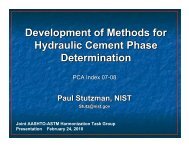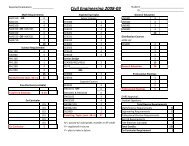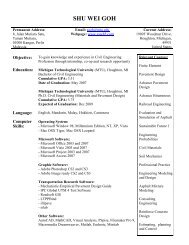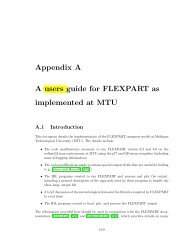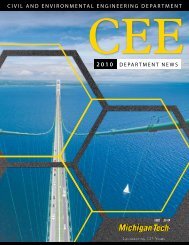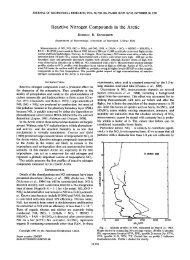Evaluation of Septic Tank and Subsurface Wetland for
Evaluation of Septic Tank and Subsurface Wetland for
Evaluation of Septic Tank and Subsurface Wetland for
Create successful ePaper yourself
Turn your PDF publications into a flip-book with our unique Google optimized e-Paper software.
organic nitrogen simultaneous to the removal <strong>of</strong> soluble ammonia. Plant senescence<br />
could have produced organic nitrogen while plant growth absorbed ammonia. In terms <strong>of</strong><br />
influent concentrations, the removal efficiencies were high <strong>for</strong> total nitrogen <strong>and</strong><br />
ammonia at the Pisgah wetl<strong>and</strong> <strong>and</strong> high <strong>for</strong> ammonia removal at the Retrieve wetl<strong>and</strong>.<br />
However, the removal <strong>of</strong> total nitrogen <strong>and</strong> ammonia in terms <strong>of</strong> areal mass loading was<br />
within the values reported in literature. It has been reported that nitrogen removal from<br />
plants can reach as high as 1.6 kg/ha-d (1.4 lb/ac-d) if regular harvesting is per<strong>for</strong>med to<br />
prevent dying plants from releasing nutrients back into the water (EPA, 2000).<br />
Optimized pilot scale harvesting <strong>of</strong> cattail was found to be every 8 weeks <strong>and</strong> resulted in<br />
total nitrogen removal <strong>of</strong> 7.1 kg/ha-d (6.3 lb/ac-d) with wetl<strong>and</strong> HRT <strong>of</strong> 5 days<br />
(Koottatep et al., 1997).<br />
The nitrate test results are presented in Table 5-5. Average nitrate concentrations in the<br />
Pisgah sanitation system were measured to be 0.2 mg/l entering the septic tanks, 0.5 mg/l<br />
exiting the septic tanks <strong>and</strong> 0.7 mg/l at the mid-wetl<strong>and</strong> sample point. Average nitrate<br />
concentrations in the Retrieve sanitation system were measured to be 0.4 mg/l entering<br />
the septic tank, 0.4 mg/l exiting the septic tank <strong>and</strong> 0.5 mg/l exiting the wetl<strong>and</strong>. These<br />
low nitrate levels indicate a normal functioning system. Nitrogen from septic tank<br />
effluent is typically more ammonia than organic nitrogen <strong>and</strong> little or no nitrate (Crites, et<br />
al., 1998). SSF wetl<strong>and</strong>s produce nitrate only when there has been biological nitrification<br />
in the wetl<strong>and</strong> <strong>and</strong> insufficient carbon <strong>for</strong> the heterotrophic bacteria to convert the nitrate<br />
to nitrogen gas (George, et al., 2000).<br />
The organic nitrogen particles entering a wetl<strong>and</strong> are trapped in the wetl<strong>and</strong> media <strong>and</strong><br />
converted by bacteria to ammonia (Reed, 2001; Tchobanoglous et al., 2003). Ammonia<br />
in the wastewater entering a wetl<strong>and</strong> may be removed by volatization to the atmosphere,<br />
plant uptake, adsorption by the media or biological nitrification <strong>and</strong> denitrification.<br />
43



